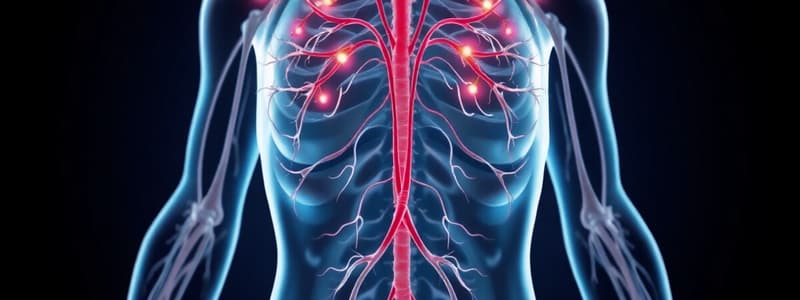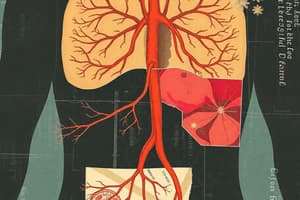Podcast
Questions and Answers
Define homeostasis in your own words.
Define homeostasis in your own words.
The maintenance of a stable internal environment in the body.
List the components involved in homeostatic regulation.
List the components involved in homeostatic regulation.
Variable, receptor, control center, and effector.
Name two systems that help achieve homeostasis.
Name two systems that help achieve homeostasis.
Endocrine and nervous systems.
What is the role of the 'receptor' in homeostatic regulation?
What is the role of the 'receptor' in homeostatic regulation?
Briefly describe how the nervous system and endocrine system differ in their method of communication.
Briefly describe how the nervous system and endocrine system differ in their method of communication.
Explain the difference between a neuroendocrine system and a peripheral endocrine system.
Explain the difference between a neuroendocrine system and a peripheral endocrine system.
Describe what negative feedback is in the context of hormones.
Describe what negative feedback is in the context of hormones.
List three roles that hormones play in changing cell activity.
List three roles that hormones play in changing cell activity.
What three characteristics are used to classify hormones?
What three characteristics are used to classify hormones?
Explain how a cell knows to respond to a specific hormone.
Explain how a cell knows to respond to a specific hormone.
How does solubility affect the location of hormone receptors?
How does solubility affect the location of hormone receptors?
Differentiate between the actions of agonists and antagonists.
Differentiate between the actions of agonists and antagonists.
What is the role of the hypothalamus in the hypothalamus-pituitary unit?
What is the role of the hypothalamus in the hypothalamus-pituitary unit?
Give two examples of how to measure stress in animals and what a downfall of each method is.
Give two examples of how to measure stress in animals and what a downfall of each method is.
Explain how 'stress' is defined, drawing on the concepts of homeostasis.
Explain how 'stress' is defined, drawing on the concepts of homeostasis.
Explain the difference between acute and chronic stress and their corresponding stress response systems.
Explain the difference between acute and chronic stress and their corresponding stress response systems.
Hormones are often classified based on their solubility. How does this classification dictate their mechanism of action at the cellular level? Give an example of a hormone from each solubility class and where the receptor is likely found for each.
Hormones are often classified based on their solubility. How does this classification dictate their mechanism of action at the cellular level? Give an example of a hormone from each solubility class and where the receptor is likely found for each.
The document mentions the 'Shiverdecker Study'. Summarize its findings and explain its significance in the context of animal welfare and stress management.
The document mentions the 'Shiverdecker Study'. Summarize its findings and explain its significance in the context of animal welfare and stress management.
Imagine a newly discovered hormone is found to primarily affect gene transcription within target cells. Based on this information, what can be inferred about its solubility and likely chemical structure? Explain your reasoning.
Imagine a newly discovered hormone is found to primarily affect gene transcription within target cells. Based on this information, what can be inferred about its solubility and likely chemical structure? Explain your reasoning.
A researcher is studying the effects of chronic social stress on cortisol levels in a group of laboratory mice. They choose to measure cortisol in fecal matter. What are the advantages and disadvantages of this method?
A researcher is studying the effects of chronic social stress on cortisol levels in a group of laboratory mice. They choose to measure cortisol in fecal matter. What are the advantages and disadvantages of this method?
Flashcards
What is homeostasis?
What is homeostasis?
The maintenance of a stable internal environment within an organism.
Homeostatic Regulation Pathway
Homeostatic Regulation Pathway
Stimulus → Receptor → Control Center → Effector → Response.
Endocrine and Nervous Systems
Endocrine and Nervous Systems
Uses chemical messengers to communicate and regulate body functions.
The Nervous System Pathway
The Nervous System Pathway
Signup and view all the flashcards
The Endocrine System Pathway
The Endocrine System Pathway
Signup and view all the flashcards
Neuroendocrine System
Neuroendocrine System
Signup and view all the flashcards
Peripheral Endocrine System
Peripheral Endocrine System
Signup and view all the flashcards
Hypothalamus-Pituitary Unit
Hypothalamus-Pituitary Unit
Signup and view all the flashcards
Feedback Mechanisms
Feedback Mechanisms
Signup and view all the flashcards
Roles of Hormones
Roles of Hormones
Signup and view all the flashcards
Cell response to a hormone
Cell response to a hormone
Signup and view all the flashcards
Hormone Solubility
Hormone Solubility
Signup and view all the flashcards
What are Agonists?
What are Agonists?
Signup and view all the flashcards
What are Antagonists?
What are Antagonists?
Signup and view all the flashcards
What is Sex determination?
What is Sex determination?
Signup and view all the flashcards
What is Stress?
What is Stress?
Signup and view all the flashcards
What is Stress Response?
What is Stress Response?
Signup and view all the flashcards
Kinds of Stress
Kinds of Stress
Signup and view all the flashcards
Stress Response Systems
Stress Response Systems
Signup and view all the flashcards
Responding to stress
Responding to stress
Signup and view all the flashcards
Study Notes
Homeostasis
- Dynamic equilibrium is maintained within the body's internal environment through homeostasis
- Homeostasis maintains balance within the body systems
Homeostatic Regulation
- A stimulus or change is detected, sent to a control system, and generates a response that is then put into play
- A variable goes to a receptor which informs a control center, which then influences an effector
Achieving Homeostasis
- Homeostasis is achieved through regulatory mechanisms that involve organs of the body
- These mechanisms include both the endocrine and nervous systems
Comparing Endocrine and Nervous Systems
- Both systems use chemical messengers called neurotransmitters
Differences between the Endocrine and Nervous Systems
- Endocrine system secretions target cells to change metabolic activities in specific cells
- The nervous system transmits nerve impulses to cause muscular contraction or gland secretion
- Endocrine responses are typically slow and prolonged
- Nervous system responses are rapid and brief
The Nervous System
- Sensory receptors send signals via afferent neurons to the central processor (brain)
- Efferent neurons then carry signals to effectors, such as muscles or glands
Endocrine System
- An endocrine gland or cell releases a hormone that travels to a target organ
Classical Vertebrate Endocrine System
- The classical vertebrate endocrine system has two divisions
- Neuroendocrine system
- Peripheral Endocrine System
Neuroendocrine System
- Neurosecretory neurons with nerve terminals release hormones into the blood or extracellular fluid (ECF)
- Examples include adrenal glands, pituitary gland, and the hypothalamus
Peripheral Endocrine System
- Non-neural tissue with no direct link to the nervous system
- Examples include the thyroid, parathyroid, pancreas, and kidneys
Hypothalamus-Pituitary Unit
- A central regulator of endocrine function
- The hypothalamus closely controls pituitary gland secretions
- All domestic animals have a hypothalamus and pituitary unit
- Pituitary hormones are not produced at a constant rate
- Production depends on animals' physiological needs
Feedback Mechanisms
- Hormonal regulation involves feedback mechanisms
- Negative feedback occurs when a hormone feeds back to decrease its own production
- Positive feedback involves the release of additional hormone in response to an original hormone release
Roles of Hormones
- Hormones can stimulate the production of new proteins
- Hormones can activate or inactivate enzymes
- Hormones can open or close cell membrane channels
- Hormones can cause a cell to secrete or release substances
Classifying Hormones
- Hormones can be classified by type of signalling, chemical structure, and solubility
Hormone Classes
- Steroids (sex and stress hormones) e.g., cortisol and estradiol
- Peptide Hormones e.g., insulin
- Amino acid derivatives e.g., thyroid hormones
- Eicosanoids e.g., prostaglandins
How Cells Respond to Hormones
- Cells respond to specific hormones via receptors on or inside target cells
- These receptors provide specificity for hormone-cell interactions
Hormone Receptors
- Hormone receptors exhibit a "lock and key" mechanism, where a conformational change occurs and the receptor is specific to a hormone
Solubility and Hormone Receptors
- Solubility dictates where the hormone receptor is located
- Water-soluble hormones cannot cross the cell membrane, so the receptor is outside the cell
- Examples include insulin and epinephrine
- Fat-soluble hormones can cross cell membranes, so the receptor can be inside the cell
- Examples include thyroid hormones and steroid hormones
Agonists vs Antagonists
- Agonists bind to a receptor to activate a biological response
- Antagonists bind to a receptor and prevent a response from occurring
- Melengestrol acetate (MGA) is a progesterone receptor antagonist
- Dexamethasone is a glucocorticoid receptor agonist
Hormonal Profile and Follicular Development
- LH triggers ovulation
- Progesterone thickens the uterine lining
- Prostaglandins stimulate shedding of the uterine lining
- Estrus releases the egg to be fertilized
Defining Male or Female
- Male or female is defined by chromosomal, gonadal, hormonal, morphological, and behavioural sex
Sex Determination
- The natural event by which an individual of a species becomes male or female
- Process: Genetic information leads to Gonadal development that leads to Phenotypic expression (physical, observable, behavioural)
Types of Sex Determination
- Genetic factors determined at fertilization combine
- Environmental factors determined after fertilization, dependant on chance, availability of resources, social factors, and temperature
Testes or Ovaries
- Gonads develop based on the presence or absence of the SRY gene
- SRY gene is found on the Y chromosome
- 'Y makes the guy'
- Female by default is XX
- If SRY is present, male organs such as testes develop
Hormone Production
- Granulosa, Leydig, and theca cells make hormones
- Egg and sperm cells do not
Stress
- An environmental change that disrupts homeostasis and is perceived as a threat
Stress Response
- A suite of physiological and behavioural responses to reestablish homeostasis
Kinds of Stress
- Acute (fight or flight) results in an alarm reaction characterized by the quick release of adrenaline from the adrenal medulla and is followed by quick recovery
- Chronic stress (constant or repeated stress) results in an impaired immune system response and general health
- Adjustments fail to compensate for stress and Cortisol is released from the adrenal cortex
Stress Response Systems
- Acute stress uses the Sympathetic-Adrenal-Medullary System (SAM)
- Chronic stress uses the Hypothalamic-Pituitary-Adrenal System (HPA)
Social Stress Factors
- Social, through isolation or introduction
- Feeding, through competition or restriction
- Management, through transportation or confinement
- Environment, through temperature or habitat loss
- Poor health, through sickness or neglect
Responding to Stress
- Responses to stress can be behavioural or physiological
- Behavioural responses include vocalization and restlessness
- Physiological responses include increased heart rate and blood pressure
Measuring Stress in Animals
- Stress can be measures through behavioural assessments
- Stress can be measured through hormonal measurements
Behavioural Assessments
- Measuring species-specific, learned behaviours, and animal preferences
- Downfall: can be dependent on many factors such as age, sex, health, and density
Behavioural Assessments
- Stress can be measured through measuring stress hormone levels in blood
- Downfall: inducing stress will skew the levels and provide inaccurate results
Measuring Cortisol
- Blood is the gold standard
- Cortisol is secreted directly into the bloodstream
- Downfall: drawing blood is stressful to the animal, and skews cortisol level results
- Saliva has a linear relationship with free cortisol in blood
- Blood cortisol increases, saliva cortisol increases
- Less stressful sampling procedure, but only the free cortisol portion is measured
- Fecal matter analysis has no interaction with animal directly
- Not as accurate as blood because of the variety of processes it has been through
- Much more variability in measurements, further away from original blood concentration
- Urine measures free cortisol levels
- Sampling time needs to be kept consistent
- Collection can be difficult
- Hair is a biomarker of chronic stress
- Can be cut or retrieved without stress to the animal
- Can be transported without compromising samples
Shiverdecker Study
- Found that human interaction decreased stress levels in shelter dogs
- Each dog was its own control where blood samples were taken before and after interactions to measure plasma cortisol levels
- All three interactions decreased cortisol levels
Studying That Suits You
Use AI to generate personalized quizzes and flashcards to suit your learning preferences.





